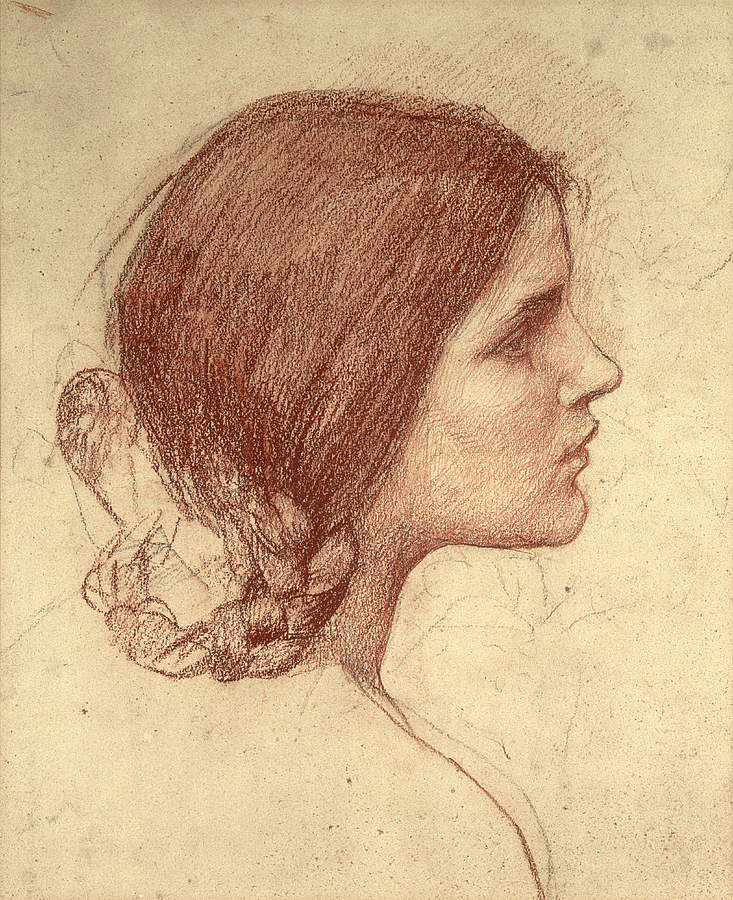
As Christopher Wood remarked in 1981 ‘One cannot help speculating about the identity of the mysterious and beautiful model who reappears so often in …Waterhouse’s pictures’ C. .Wood, The Pre-Raphaelites, London, 1981). In the early years of Waterhouse’s career it appears that his sisters, Jessie and Mary, and his wife, Esther, fulfilled the role of artist’s model; however once he became an established painter, three other women seem to have become his regular models.
The most consistent of these was Miss Muriel Foster, and it is possibly her features that we see in the present drawing. Her name is known from a single inscription on a pencil sketch for Lamia, 1905 (private collection); however her face is perhaps one of the best known in Pre-Raphaelite art. If we look at the characteristic tilt of the model’s long neck, her slightly pointed chin, fractionally upturned nose, delicately modelled lips and loosely plaited hair, we can see the face of the woman who appears in some of Waterhouse’s most famous paintings. She is recognisable in La Belle Dame Sans Merci, 1893 (Hessisches Landesmuseum, Darmstadt), Psyche opening the Door into Cupid’s Garden, circa 1900, (Harris Muesum and Art Gallery, Preston), and A Mermaid, 1892-1900 (Royal Academy of Arts, London) amongst others.
Baker and Baker, ‘Miss Muriel Foster: The John William Waterhouse Model’, The Journal of Pre-Raphaelite Studies, 8, Toronto, Fall 1999, suggest that Muriel Foster sat for all Waterhouse’s paintings between 1893 and 1906 and again for those at the end of his life. Waterhouse’s two other models appear to have sat for fewer pictures than Muriel Foster. The dark intense features of one whose identity is still unknown appears in Circe Offering the Cup to Odysseus, 1891 (Oldham Art Gallery) and Circe Invidiosa, 1892 (Art Gallery of South Australia, Adelaide) and the slightly less elfin features of Beatrice Ethel Hackman are most likely depicted in the previous lot 3.
Although there is no evidence of anything other than admiration between the artist and his model, Waterhouse’s dedication to Muriel Foster as a sitter was extraordinary. It is thought that she is the same Muriel Foster who appears in a birth register at Greenwich in 1878, who trained as a nurse and remained unmarried until her death at the age of ninety-one. Although the model’s appearance varies frequently in terms of hair-colour and attitude, through the years we see her maturing under the artist’s brush. Her soft teenage features in his early works such as La Belle Dame Sans Merci become the sharper, clearly defined features of a woman in The Enchanted Garden, 1916-17 (Lady Lever Art Gallery, Port Sunlight), one of the last pictures that Waterhouse ever painted.
The softness and warmth of the red chalk used in the present drawing compliments the sensitivity of Waterhouse’s modelling. The use of this medium, instead of a harder graphite pencil, lends the study the depth and richness characteristic of his finished oils. Although we cannot be certain that the present drawing is of Muriel Foster, the beautiful intimacy of this chalk study appears to demonstrate the effortless tracing of a familiar face.
